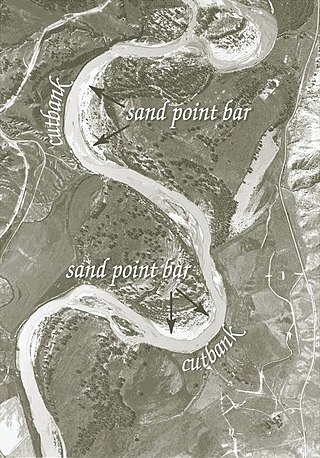Top Qs
Timeline
Chat
Perspective
Cut bank
Outside bank of a water channel, which is continually undergoing erosion From Wikipedia, the free encyclopedia
Remove ads
A cut bank, also known as a river cliff or river-cut cliff, is the outside bank of a curve (meander) in a water channel (stream), which is continually undergoing erosion.[1] Cut banks are found in abundance along mature or meandering streams, they are located opposite the slip-off slope on the inside of the stream meander. They are shaped much like a small cliff, and are formed as the stream collides with the river bank. It is the opposite of a point bar, which is an area of deposition of material eroded upstream in a cut bank.
This article has multiple issues. Please help improve it or discuss these issues on the talk page. (Learn how and when to remove these messages)
|


Typically, cut banks are steep and may be nearly vertical. Often, particularly during periods of high rainfall and higher-than average water levels, trees and poorly placed buildings can fall into the stream due to mass wasting events. Given enough time, the combination of erosion along cut banks and deposition along point bars can lead to the formation of an oxbow lake.
Not only are cut banks steep and unstable, they are also the area of a stream where the water is flowing the fastest and often deeper. In geology, this is known as an area of "high-energy".


Remove ads
See also
- Bank erosion – Marginal wear of a watercourse
- Point bar – Landform related to streams and rivers
- Slip-off slope – Depositional landform on the inside convex bank of a meandering river
References
Wikiwand - on
Seamless Wikipedia browsing. On steroids.
Remove ads
